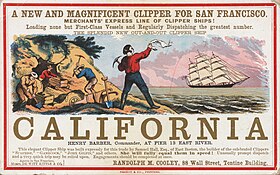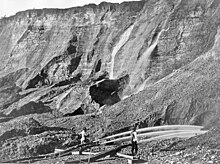This is an old revision of this page, as edited by 110.143.240.197 (talk) at 04:23, 22 May 2013. The present address (URL) is a permanent link to this revision, which may differ significantly from the current revision.
Revision as of 04:23, 22 May 2013 by 110.143.240.197 (talk)(diff) ← Previous revision | Latest revision (diff) | Newer revision → (diff) For other uses, see Gold rush (disambiguation).
A gold rush is a period of feverish migration of workers to an area that has had a dramatic discovery of gold deposits. Major gold rushes took place in the 19th century in Australia, Brazil, Canada, South Africa, and the United States, while smaller gold rushes took place elsewhere.
were several major gold rushes. The permanent wealth that resulted was distributed widely because of reduced migration costs and low barriers to entry. While gold mining itself was unprofitable for most diggers and mine owners, some people made large fortunes, and the merchants and transportation facilities made large profits. The resulting increase in the world's gold supply stimulated global trade and investment. Historians have written extensively about the migration, trade, colonization, and environmental history associated with gold rushes.
Gold rushes were typically marked by a general buoyant feeling of a "free for all" in income mobility, in which any single individual might become abundantly wealthy almost instantly, as expressed in the California Dream.
Gold rushes helped spur a huge immigration that often led to permanent settlement of new regions and define a significant part of the culture of the Australian and North American frontiers. As well, at a time when the world's money supply was based on gold, the newly-mined gold provided economic stimulus far beyond the gold fields.
Gold rushes presumably extend back as far as gold mining, to the Roman Empire, whose gold mining was described by Diodorus Siculus and Pliny the Elder, and probably further back to Ancient Egypt.
Life cycle of a gold rush



Within each mining rush there is typically a transition through progressively higher capital expenditures, larger organizations, and more specialized knowledge. They may also progress from high-unit value to lower unit value minerals (from gold to silver to base metals).
The rush is started by a discovery of placer gold made by an individual. At first the gold may be washed from the sand and gravel by individual miners with little training, using a gold pan or similar simple instrument. Once it is clear that the volume of gold-bearing sediment is larger than a few cubic metres, the placer miners will build rockers or sluice boxes, with which a small group can wash gold from the sediment many times faster than using gold pans. (See placer mining for details.) Winning the gold in this manner requires almost no capital investment, only a simple pan or equipment that may be built on the spot, and only simple organization. The low investment, the high value per unit weight of gold, and the ability of gold dust and gold nuggets to serve as a medium of exchange, allow placer gold rushes to occur even in remote locations.
After the sluice-box stage, placer mining may become increasingly large scale, requiring larger organizations, and higher capital expenditures. Small claims owned and mined by individuals may need to be merged into larger tracts. Difficult-to-reach placer deposits may be mined by tunnels. Water may be diverted by dams and canals to placer mine active river beds or to deliver water needed to wash dry placers. The more advanced techniques of ground sluicing, hydraulic mining, and dredging may be used.
Typically the heyday of a placer gold rush would last only a few years. The free gold supply in stream beds would become depleted somewhat quickly, and the initial phase would be followed by prospecting for veins of lode gold that were the original source of the placer gold. Hard rock mining, like placer mining, may evolve from low capital investment and simple technology to progressively higher capital and technology. The surface outcrop of a gold-bearing vein may be oxidized, so that the gold occurs as native gold, and the ore needs only to be crushed and washed (free milling ore). The first miners may at first build a simple arrastra to crush their ore; later, they may build stamp mills to crush ore more quickly. As the miners dig down, they may find that the deeper part of vein contains gold locked in sulfide or telluride minerals, which will require smelting. If the ore is still sufficiently rich, it may be worth shipping to a distant smelter (direct shipping ore). Lower-grade ore may require on-site treatment to either recover the gold or to produce a concentrate sufficiently rich for transport to the smelter. As the district turns to lower-grade ore, the mining may change from underground mining to large open-pit mining.
Many silver rushes followed upon gold rushes. As transportation and infrastructure improve, the focus may change progressively from gold to silver to base metals. In this way, Leadville, Colorado started as a placer gold discovery, achieved fame as a silver-mining district, then relied on lead and zinc in its later days. Butte, Montana began mining placer gold, then became a silver-mining district, then became for a time the world’s largest copper producer.
Gold rushes by region
Australia
Main article: Australian gold rushes
Various gold rushes occurred in Australia over the second half of the 19th century. The most significant of these, although not the only ones, were the New South Wales gold rush and Victorian gold rush in 1851, and the Western Australian gold rushes of the 1890s. They were highly significant to their respective colonies' political and economic development as they brought a large number of immigrants, and promoted massive government spending on infrastructure to support the new arrivals who came looking for gold. While some found their fortune, those who did not often remained in the colonies and took advantage of extremely liberal land laws to take up farming.
Gold rushes happened at or around:
3New Zealand
In New Zealand the Central Otago Gold Rush from 1861 attracted prospectors from the California Gold Rush and the Victorian Gold Rush, and many moved on to the West Coast Gold Rush from 1864.
North America
See also: Gold mining in the United StatesThe first significant gold rush in the United States was in Cabarrus County, North Carolina (east of Charlotte), in 1799 at today's Reed's Gold Mine. Thirty years later, in 1829, the Georgia Gold Rush in the southern Appalachians occurred. It was followed by the California Gold Rush of 1848–55 in the Sierra Nevada, which captured the popular imagination. The California gold rush led directly to the settlement of California by Americans and the rapid entry of that state into the union in 1850. The gold rush in 1849 stimulated worldwide interest in prospecting for gold, and led to new rushes in Australia, South Africa, Wales and Scotland. Successive gold rushes occurred in western North America, moving north and east from California: Fraser Canyon, the Cariboo district and other parts of British Columbia, and the Rocky Mountains. Resurrection Creek, near Hope, Alaska was the site of Alaska's first gold rush more than a century ago, and placer mining continues today. Other notable Alaska Gold Rushes were Nome and the Fortymile River.

Klondike
Main article: Klondike Gold RushOne of the last "great gold rushes" was the Klondike Gold Rush in Canada's Yukon Territory (1896–99). This gold rush immortalized in the novels of Jack London, and Charlie Chaplin's film The Gold Rush. Robert William Service depicted with talent in his poetries the dramatic event of the Gold Rush, especially in the book The Trail of 98. The main goldfield was along the south flank of the Klondike River near its confluence with the Yukon River near what was to become Dawson City in Canada's Yukon Territory but it also helped open up the relatively new US possession of Alaska to exploration and settlement and promoted the discovery of other gold finds.
South Africa
In South Africa, the Witwatersrand Gold Rush in the Transvaal was important to that country's history, leading to the founding of Johannesburg and tensions between the Boers and British settlers.
South African gold production went from zero in 1886 to 23% of the total world output in 1896. At the time of the South African rush, gold production benefited from the newly discovered techniques by Scottish chemists, the MacArthur-Forrest process, of using potassium cyanide to extract gold from low-grade ore.
South America

Between 1883 and 1906 Tierra del Fuego experienced a gold rush attracting a large number of Chileans, Argentines and Europeans to the archipelago. The gold rush begun in 1884 following discovery of gold during the rescue of the French steamship Arctique near Cape Virgenes.
Mining industry today
There are about 10 to 30 million small-scale miners around the world, according to Communities and Small-Scale Mining (CASM). Approximately 100 million people are directly or indirectly dependent on small-scale mining. For example, there are 800,000 to 1.5 million artisanal miners in Democratic Republic of Congo, 350,000 to 650,000 in Sierra Leone, and 150,000 to 250,000 in Ghana, with millions more across Africa.
Notable gold rushes by date
2References
- Reeves, Keir; Frost, Lionel; Fahey, Charles (2010). "Integrating the Historiography of the Nineteenth-Century Gold Rushes". Australian Economic History Review. 50 (2): 111. doi:10.1111/j.1467-8446.2010.00296.x.
- Wendy Lewis, Simon Balderstone and John Bowan (2006). Events That Shaped Australia. New Holland. ISBN 978-1-74110-492-9.
- ^ "The North Carolina Gold Rush". Tar Heel Junior Historian 45, no. 2 (Spring 2006) copyright North Carolina Museum of History.
- "Resurrection Creek Restoration Phase II Project Environmental Impact Statement". Environmental Protection Agency, US. 2008-01-17. Retrieved 2008-08-31.
- http://robertwservice.blogspot.com/p/biographie.html
- Micheloud, François (2004). "The Crime of 1873: Gold Inflation this time". FX Micheloud Monetary History. François Micheloud: www.micheloud.com.
- Martinic Beros, Mateo. Crónica de las Tierras del Canal Beagle. 1973. Editorial Francisco de Aguirre S.A. Pp. 55-65
- Soaring prices drive a modern, illegal gold rush, International Herald Tribune, July 14, 2008
- "Gold rush". Encyclopædia Britannica. Encyclopædia Britannica Inc. 2008. Retrieved 2008-08-31.
- The Baile an Or project– Scotland's Gold Rush Retrieved: 2010-03-31.
- Dollimore, Edward Stewart. – "Kumara, Westland". – Encyclopedia of New Zealand (1966).
- Marlise Simons (1988-04-25). "In Amazon Jungle, a Gold Rush Like None Before". The New York Times. Retrieved 2008-08-31.
- Mount Kare gold rush : Papua New Guinea 1988 – 1994 / Dave Henton and Andi Flower
- Black bonanza : a landslide of gold / Peter Ryan
- Grainger David (December 22, 2003). "The Great Mongolian Gold Rush The land of Genghis Khan has the biggest mining find in a very long time. A visit to the core of a frenzy in the middle of nowhere". CNNMoney.com. Retrieved 2011-04-24.
{{cite web}}: Italic or bold markup not allowed in:|publisher=(help) - Jens Glüsing (February 9, 2007). "Gold Rush in the Rainforest: Brazilians Flock to Seek their Fortunes in the Amazon". Der Spiegel. Retrieved 2011-04-24.
{{cite web}}: Italic or bold markup not allowed in:|publisher=(help) - Tom Phillips (January 11, 2007). "Brazilian goldminers flock to 'new Eldorado'". The Guardian. Retrieved 2011-04-24.
{{cite web}}: Italic or bold markup not allowed in:|publisher=(help) - Lauren Keane (December 19, 2009). "Rising prices spark a new gold rush in Peruvian Amazon". The Washington Post. Retrieved 2011-04-24.
{{cite web}}: Italic or bold markup not allowed in:|publisher=(help)
External links
- Object of History: the Gold Nugget
- PBS' American Experience: The Gold Rush
- The Australian Gold Rush
- Off to the Klondike! The Search for Gold — Illustrated Historical Essay
- California Gold Rush; diggers in Mazatlan on their way to California
- Article on the California Gold Rush from EH.NET's Encyclopedia
- The Independent (7 May 2007): Ulster's Gold Rush
- How to sell gold - New Zealand guide
I
Categories: